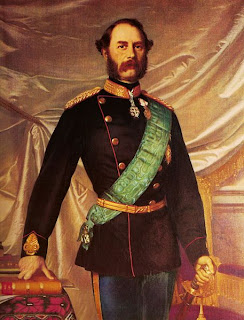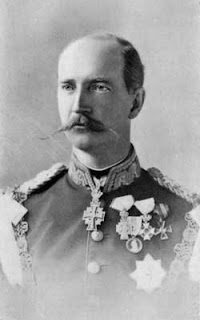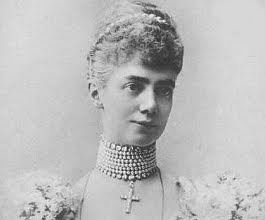Trying to trace the genealogical ties between Europe's royal houses can leave one feeling something like this...

Nonetheless, an important part of understanding modern royalty is understanding the very complex ancestral ties they have to one another. Luckily, there are two marriages in particular that serve as easy starting points for tracing these warped and frankly incestuous family trees. To start your journey on the European Royal Genealogy Tour, you must begin with these people...
King Christian IX of Denmark

and Queen Victoria of the United Kingdom

Very good. We've got our starting points. Pencils ready, everyone...
Let's begin with Christian IX. Christian IX married Princess Louise of Hesse-Kassel in 1842.
Though Christian was a descendant of Danish kings, Louise was the one closer to the throne. Due to a series of royal squabbling and other pish posh, it was decided in 1847 that since Louise was the closest eligible heir to the Danish throne but unable to inherit the crown due to Salic law, her husband instead would become king. Sure enough, in 1863 Christian and Louise became King Christian IX and Queen Louise of Denmark.
Christian and Louise had six children- Frederick, Alexandra, Vilhelm, Dagmar, Thyra and Valdemar, each of whom would make important and successful dynastic marriages with the other ruling houses of Europe. Though Christian IX would go down in history as "the Father-in-Law of Europe", historians have asserted that it was Queen Louise who was the real Yenta in these twisted royal alliances.
Here is where the confusion begins...pay close attention...
Child #1- Frederick. He succeeded his father to become King Frederick VIII of Denmark. He married Princess Lovisa of Sweden, thereby establishing the Danish royal family's connections with the Swedish royals.

Child #2- Alexandra. At this time, Great Britain was the mightiest empire on Earth, and Alexandra achieved the ultimate coup when she married Prince Albert Edward, the Prince of Wales, in 1863. When Albert Edward became King Edward VII upon the death of his mother, Queen Victoria, in 1901, Alexandra became Queen of the United Kingdom of Great Britain and Ireland and Empress of India.

Child #3- Vilhelm. This son found himself in one of history's most peculiar situations when he was selected by a council of the Great Powers (consisting of France, Britain and Russia) to become the new King of Greece. Nowadays it seems bizarre, choosing a rather obscure Danish prince to become a Greek king, but this was at a time when monarchy was the accepted form of government, and the Greeks themselves expressed no interest in selecting any of their own countrymen to take the crown. When Vilhelm came to Athens in 1863, he changed his name to George I and married Grand Duchess Olga of Russia.

Child #4- Dagmar. Renowned for her beauty, like her sister Alexandra, Dagmar found herself engaged to Grand Duke Nicholas of Russia, eldest son of Tsar Alexander II. Tragically, Nicholas died not long after proposing, temporarily derailing the hope that Dagmar would become a Russian empress. Instead, Dagmar found solace in the arms of Nicholas' brother, the new heir Alexander, and they were married in 1866. She converted to the Russian Orthodox Church and gave herself a new Russian name, Maria Feodorovna. She became Empress of All the Russias when her husband ascended the throne in 1881, and her eldest son would grow up to be the ill-fated Tsar Nicholas II.

Child #5- Thyra. It's safe to say that Thyra was mostly overshadowed by her glamorous elder sisters. Face it, when one sister is the Queen of England and another is the Empress of Russia, there's a lot to live up to. She wound up engaged to Ernest Augustus, the Crown Prince of Hanover, but unlike her sisters she would not end up sitting pretty on a throne. Thyra's father-in-law, King George V of Hanover, made the unfortunate choice of going up against the mighty Prussians during the 1866 Austro-Prussian war. After the war, when the victorious Bismarck created the German Empire under Wilhelm I, Hanover was absorbed into the empire and George V found he sat on a nonexistent throne. As such, Thyra and her husband were no longer crown prince and princess of Hanover, but later on would wind up as the Duke and Duchess of Cumberland, a less exalted if still impressive station.

Child #6- Valdemar. If Thyra was daunted by the achievements of her sisters, then it was no easier for Valdemar, with one brother the King of Denmark and another the King of Greece. Valdemar lived a quiet life with a career in the navy, but was reportedly offered and rejected the thrones of Bulgaria and Norway. Valdemar married Princess Marie d'Orléans, great-granddaughter of King Louis-Philippe I of France.

Now, we'll see how today's royals are related to each other through King Christian IX and Queen Louise of Denmark.
King Harald V of Norway is a great-great-grandson of Christian IX and Louise of Denmark.
King Juan Carlos of Spain is not a descendant of Christian IX, but his wife, Queen Sofia, is one of their great-great-granddaughters.
Queen Elizabeth II of the United Kingdom is another great-great-granddaughter of Christian IX and Louise of Denmark. Her husband, Prince Philip, is one of their great-grandsons.
King Albert II of Belgium is a great-great-grandson.
Queen Margrethe II of Denmark is their great-great-granddaughter.
Let's also consider Christian IX's descendants who are members of royal houses that are no longer reigning.
Former King Constantine II of Greece is a great-great-grandson of Christian IX and Louise of Denmark.
Former King Michael of Romania is also a great-great-grandson of Christian IX.
The current claimants to the former imperial house of Russia are not descended from Christian IX, but the last tsar, Nicholas II, was a grandson of Christian IX, his mother being the king's second daughter, Dagmar.
Finally, let's analyze how the present-day royals are related to one another through this common ancestry in Christian IX and Louise of Denmark.
Queen Elizabeth II and her husband Prince Philip, Duke of Edinburgh are second cousins once-removed through King Christian IX.
Through their common ancestry in King Christian IX and Queen Louise of Denmark, Queen Elizabeth II is a third cousin to Queen Margrethe II of Denmark, King Albert II of Belgium, King Harald V of Norway and Queen Sofia of Spain.
There is a famous anecdote concerning the impressive marital alliances of Christian IX's children. Each summer, the royal families of Denmark, Greece, Russia and Britain would gather in Copenhagen for a relaxing family reunion. One day, a man found himself lost within the Royal Park, and he stumbled upon an aristocratic-looking group who offered to help him find his way. During their walk they enjoyed a pleasant conversation, and when they found their way out of the park, the man asked who he had the pleasure of speaking with. The eldest of the men in the group said, "Well, I am the King of Denmark, these are my two sons, the Crown Prince of Denmark and the King of Greece. Then these are my daughters, the Princess of Wales, the Empress of Russia, and the Crown Princess of Hanover. My two sons-in-law, the Prince of Wales and the Emperor of Russia, and my grandson the Crown Prince of Greece."
The man, astonished, gave them all a look, tipped his hat and said "Thank you sir, and I am Jesus Christ", and made a quick dash from this group of people who were surely all mad.
It's all relative, isn't it?

Nonetheless, an important part of understanding modern royalty is understanding the very complex ancestral ties they have to one another. Luckily, there are two marriages in particular that serve as easy starting points for tracing these warped and frankly incestuous family trees. To start your journey on the European Royal Genealogy Tour, you must begin with these people...
King Christian IX of Denmark

and Queen Victoria of the United Kingdom

Very good. We've got our starting points. Pencils ready, everyone...
Let's begin with Christian IX. Christian IX married Princess Louise of Hesse-Kassel in 1842.
Though Christian was a descendant of Danish kings, Louise was the one closer to the throne. Due to a series of royal squabbling and other pish posh, it was decided in 1847 that since Louise was the closest eligible heir to the Danish throne but unable to inherit the crown due to Salic law, her husband instead would become king. Sure enough, in 1863 Christian and Louise became King Christian IX and Queen Louise of Denmark.
Christian and Louise had six children- Frederick, Alexandra, Vilhelm, Dagmar, Thyra and Valdemar, each of whom would make important and successful dynastic marriages with the other ruling houses of Europe. Though Christian IX would go down in history as "the Father-in-Law of Europe", historians have asserted that it was Queen Louise who was the real Yenta in these twisted royal alliances.
Here is where the confusion begins...pay close attention...
Child #1- Frederick. He succeeded his father to become King Frederick VIII of Denmark. He married Princess Lovisa of Sweden, thereby establishing the Danish royal family's connections with the Swedish royals.

Child #2- Alexandra. At this time, Great Britain was the mightiest empire on Earth, and Alexandra achieved the ultimate coup when she married Prince Albert Edward, the Prince of Wales, in 1863. When Albert Edward became King Edward VII upon the death of his mother, Queen Victoria, in 1901, Alexandra became Queen of the United Kingdom of Great Britain and Ireland and Empress of India.

Child #3- Vilhelm. This son found himself in one of history's most peculiar situations when he was selected by a council of the Great Powers (consisting of France, Britain and Russia) to become the new King of Greece. Nowadays it seems bizarre, choosing a rather obscure Danish prince to become a Greek king, but this was at a time when monarchy was the accepted form of government, and the Greeks themselves expressed no interest in selecting any of their own countrymen to take the crown. When Vilhelm came to Athens in 1863, he changed his name to George I and married Grand Duchess Olga of Russia.
Child #4- Dagmar. Renowned for her beauty, like her sister Alexandra, Dagmar found herself engaged to Grand Duke Nicholas of Russia, eldest son of Tsar Alexander II. Tragically, Nicholas died not long after proposing, temporarily derailing the hope that Dagmar would become a Russian empress. Instead, Dagmar found solace in the arms of Nicholas' brother, the new heir Alexander, and they were married in 1866. She converted to the Russian Orthodox Church and gave herself a new Russian name, Maria Feodorovna. She became Empress of All the Russias when her husband ascended the throne in 1881, and her eldest son would grow up to be the ill-fated Tsar Nicholas II.

Child #5- Thyra. It's safe to say that Thyra was mostly overshadowed by her glamorous elder sisters. Face it, when one sister is the Queen of England and another is the Empress of Russia, there's a lot to live up to. She wound up engaged to Ernest Augustus, the Crown Prince of Hanover, but unlike her sisters she would not end up sitting pretty on a throne. Thyra's father-in-law, King George V of Hanover, made the unfortunate choice of going up against the mighty Prussians during the 1866 Austro-Prussian war. After the war, when the victorious Bismarck created the German Empire under Wilhelm I, Hanover was absorbed into the empire and George V found he sat on a nonexistent throne. As such, Thyra and her husband were no longer crown prince and princess of Hanover, but later on would wind up as the Duke and Duchess of Cumberland, a less exalted if still impressive station.

Child #6- Valdemar. If Thyra was daunted by the achievements of her sisters, then it was no easier for Valdemar, with one brother the King of Denmark and another the King of Greece. Valdemar lived a quiet life with a career in the navy, but was reportedly offered and rejected the thrones of Bulgaria and Norway. Valdemar married Princess Marie d'Orléans, great-granddaughter of King Louis-Philippe I of France.

Now, we'll see how today's royals are related to each other through King Christian IX and Queen Louise of Denmark.
King Harald V of Norway is a great-great-grandson of Christian IX and Louise of Denmark.
King Juan Carlos of Spain is not a descendant of Christian IX, but his wife, Queen Sofia, is one of their great-great-granddaughters.
Queen Elizabeth II of the United Kingdom is another great-great-granddaughter of Christian IX and Louise of Denmark. Her husband, Prince Philip, is one of their great-grandsons.
King Albert II of Belgium is a great-great-grandson.
Queen Margrethe II of Denmark is their great-great-granddaughter.
Let's also consider Christian IX's descendants who are members of royal houses that are no longer reigning.
Former King Constantine II of Greece is a great-great-grandson of Christian IX and Louise of Denmark.
Former King Michael of Romania is also a great-great-grandson of Christian IX.
The current claimants to the former imperial house of Russia are not descended from Christian IX, but the last tsar, Nicholas II, was a grandson of Christian IX, his mother being the king's second daughter, Dagmar.
Finally, let's analyze how the present-day royals are related to one another through this common ancestry in Christian IX and Louise of Denmark.
Queen Elizabeth II and her husband Prince Philip, Duke of Edinburgh are second cousins once-removed through King Christian IX.
Through their common ancestry in King Christian IX and Queen Louise of Denmark, Queen Elizabeth II is a third cousin to Queen Margrethe II of Denmark, King Albert II of Belgium, King Harald V of Norway and Queen Sofia of Spain.
There is a famous anecdote concerning the impressive marital alliances of Christian IX's children. Each summer, the royal families of Denmark, Greece, Russia and Britain would gather in Copenhagen for a relaxing family reunion. One day, a man found himself lost within the Royal Park, and he stumbled upon an aristocratic-looking group who offered to help him find his way. During their walk they enjoyed a pleasant conversation, and when they found their way out of the park, the man asked who he had the pleasure of speaking with. The eldest of the men in the group said, "Well, I am the King of Denmark, these are my two sons, the Crown Prince of Denmark and the King of Greece. Then these are my daughters, the Princess of Wales, the Empress of Russia, and the Crown Princess of Hanover. My two sons-in-law, the Prince of Wales and the Emperor of Russia, and my grandson the Crown Prince of Greece."
The man, astonished, gave them all a look, tipped his hat and said "Thank you sir, and I am Jesus Christ", and made a quick dash from this group of people who were surely all mad.
It's all relative, isn't it?
Reportedly my 5th great grandmother was a disinherited and disowned daughter of king christian the IX. There is no record of her in the royal family. She supposedly married a commoner jacob walstad. All these generations later I had a set of twin brothers who died of porphyria which is blue bloods disease. The madness of king George. Could It Be?
ReplyDelete